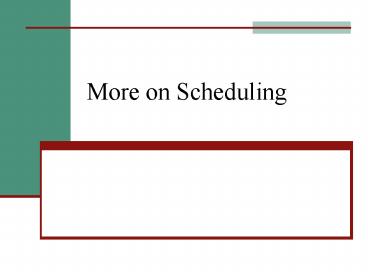More on Scheduling - PowerPoint PPT Presentation
Title:
More on Scheduling
Description:
More on Scheduling – PowerPoint PPT presentation
Number of Views:23
Avg rating:3.0/5.0
Title: More on Scheduling
1
More on Scheduling
2
Recap of Last Class
- Activity dependencies are shown through
CPM/PERT Chart. - Critical path
- Completion date
- Slack time in non-critical path activities
- Activity start and end dates and personnel
responsibilities shown on Gantt Chart.
3
Managing Uncertainty
- Q How confident can we be in our milestone dates
and the delivery date? - A Using confidence and Statistics
- for each task, determine pessimistic and
optimistic times - if PT-OT is small for all tasks, then great!!!
- compute average PT-OT, and std dev
- if a task's PT-OT is outside the std dev, worry
about that task
4
Managing Uncertainty
- Q Where do we schedule uncertainty time?
- A1 spread it out by bumping each milestone.
- used by Critical Path
- A2 lump it together as one activity at end.
- used by Critical Chain
5
Common PERT Problems
- Missing dependencies
- Misinterpretation
6
Example
- K integration testing
- L Install Software
- M Write Manual
- N Train Users
L
K
M
N
3
4
5
2
1
7
Example
- K integration testing
- L Install Software
- M Write Manual
- N Train Users
L
K
M
N
3
4
5
2
1
But wait, we can shorten the project if we write
the manual right after testing is finished. (L
and M can be done in parallel.) So
8
Example
- K integration testing
- L Install Software
- M Write Manual
- N Train Users
L
3
K
2
1
M
N
4
5
But wait, the system needs to be installed
before we can use it to train people. So
9
Example
- K integration testing
- L Install Software
- M Write Manual
- N Train Users
L
3
K
2
1
5
M
N
4
But what is that activity between dates 3 and 4?
So
10
Example
- K integration testing
- L Install Software
- M Write Manual
- N Train Users
L
3
K
2
1
5
M
N
4
Dashed line is a dummy activity.
11
Example
- K integration testing
- L Install Software
- M Write Manual
- N Train Users
L
K
N
M
Note dummies not needed with "activity on node"
graphs.
12
Resource Leveling
- Activity Shifting
- to avoid using resources during a peak time.
- use slack in start and end dates
- Activity Splitting
- to shorten duration
- break activity into pieces when more resources
are available - Optimize the System, not individual tasks
- Leveling usually yields longer projects
13
Example
B 2wk
C 2wks
D 2wks
H 3wks
I 2wks
A 3wks
E 2wks
F 5wks
G 3wks
- What is the completion time?
- Since F is so long, what would be the completion
time if we break it into two parallel parts of
2wks and 3wks?
14
Theory of Constraints
- The Goal by Goldratt in 1997
- Traditional approach is to divide and divide into
manageable parts, then optimize these parts. - TOC looks at the whole system.
- Identify In order to manage a constraint, it is
first necessary to identify it. - Exploit Focus on how to get more production
within the existing capacity limitations. - Subordinate Prevent the materials needed next
from waiting in a queue at a non-constraint
resource. - Elevate If, after fully exploiting this process,
it still cannot produce enough products to meet
market demand, find other ways to increase
capacity. - Go back to Step 1.
15
Scheduling Tools
- Gantt Chart producers
- MS Project
- Web access
- Supports multiple projects
- Dependencies
- Billing support
- Resources leveling
- Gantt charts, activity network,
16
MS Project
17
Open WorkBench
18
ATC Professional

